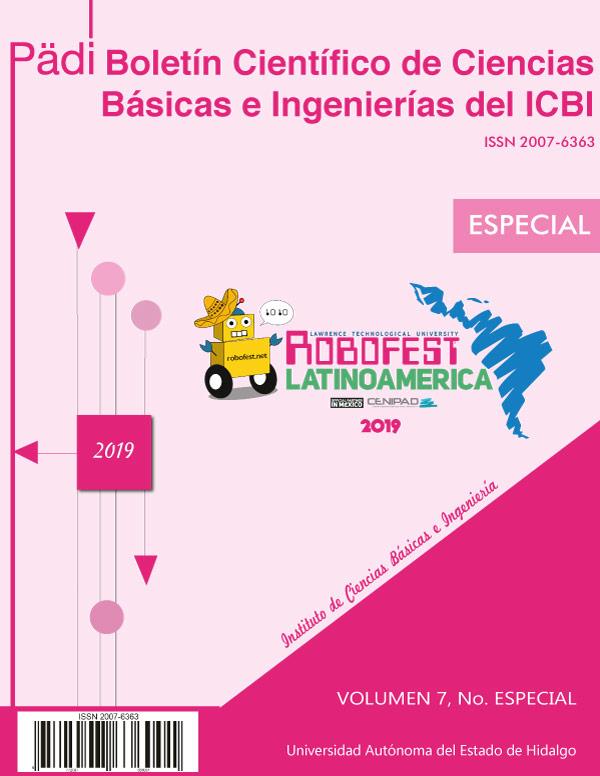Design of a knee joint based on four crossed bar chebyshev Type polycentric mechanism
Abstract
The present work presents the results of the design of a
knee joint for prostheses, exoskeletons and bipedal robots, made
from the geometric synthesis for planar mechanisms. Taking
advantage of the anatomical advantages provided by the mechanisms
of four bars to reproduce the movement of the knee
on the sagittal axis, in the gait cycle; a configuration of crossed
bars is presented, which mimics the performance of the crossed
ligaments of the knee. According to the results obtained, it was
possible to construct a minimum prototype of an active transfemoral
prosthesis to perform the complete cycle of gait, which
is adequate to the parameters of locomotion in adults.
Downloads
References
Etchechoury, M. d. R., 2001. Sistemas diferenciales-algebraicos: aplicaciones a perturbación singular y control. Ph.D. thesis, Facultad de Ciencias Exactas.
Gini, G., Scarfogliero, U., Folgheraiter, M., 2007. Human-oriented biped robot design: Insights into the development of a truly anthropomorphic leg. In: Proceedings 2007 IEEE International Conference on Robotics and Automation. IEEE, pp. 2910–2915.
Hamill, J., Knutzen, K. M., 2006. Biomechanical basis of human movement. Lippincott Williams & Wilkins.
Haug, E. J., 1984. Computer aided analysis and optimization of mechanical system dynamics. Springer-Verlag Berlin Heidelberg.
Haug, E. J., 1989. Computer aided kinematics and dynamics of mechanical systems. Vol. 1. Allyn and Bacon Boston.
Herr, H., Wilkenfeld, A., 2003. User-adaptive control of a magnetorheological prosthetic knee. Industrial Robot: An International Journal 30 (1), 42–55.
Kempe, A. B., 1875. On a general method of describing plane curves of the nth degree by linkwork. Proceedings of the London Mathematical Society 1 (1), 213–216.
Kempe, A. B., 1877. How to draw a straight line: a lecture on linkages. Macmillan and Company.
Martinez, R. C., Avitia, R. L., Bravo, M. E., Carranza, M. A. R., 2014. A low cost design of powered ankle-knee prosthesis for lower limb amputeespreliminary results. In: BIODEVICES. pp. 253–258.
Miller, L. A., Childress, D. S., may 2005. Problems associated with the use of inverse dynamics in prosthetic applications: An example using a polycentric prosthetic knee. Robotica 23 (3), 329–335. DOI: 10.1017/s0263574704001353
Narang, Y. S., Arelekatti, V. N. M., Winter, A. G., jul 2016. The effects of prosthesis inertial properties on prosthetic knee moment and hip energetics required to achieve able-bodied kinematics. IEEE Trans. Neural Syst. Rehabil. Eng. 24 (7), 754–763. DOI: 10.1109/tnsre.2015.2455054
Nikravesh, P. E., 1988. Computer-aided analysis of mechanical systems. Prentice-Hall, Inc.
Perry, J., 1992. Gait Analysis: Normal and Pathological Function. Slack Incorporated.
Poznyak, A., 2005. Modelado matemático de los sistemas mecánicos, eléctricos y electromecánicos.
Radcliffe, C. W., Deg, M., 2003. Biomechanics of knee stability control with four-bar prosthetic knees. In: Proc. ISPO Australia Annual Meeting.
Toussaint, G., 2003. Simple proofs of a geometric property of four-bar linkages. The American mathematical monthly 110 (6), 482.
Winter, D. A., 2009. Biomechanics and motor control of human movement. John Wiley & Sons.
Xydas, E. G., aug 2014. Synthesis and analysis of a chebyschev’s straight line four-bar linkage for generating a minimum jerk velocity profile. In: Volume 5A: 38th Mechanisms and Robotics Conference. ASME International. DOI: 10.1115/detc2014-35510













